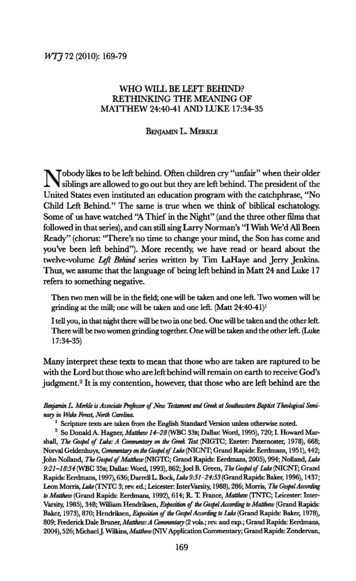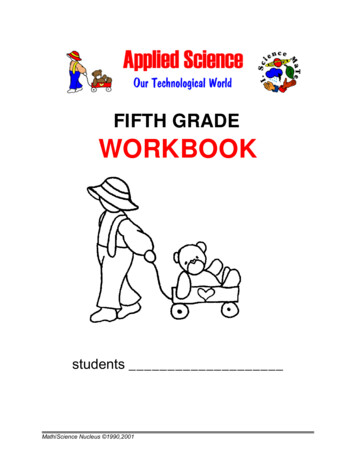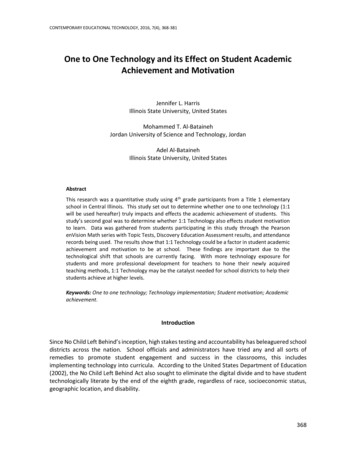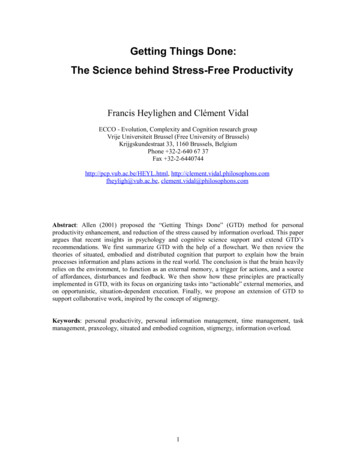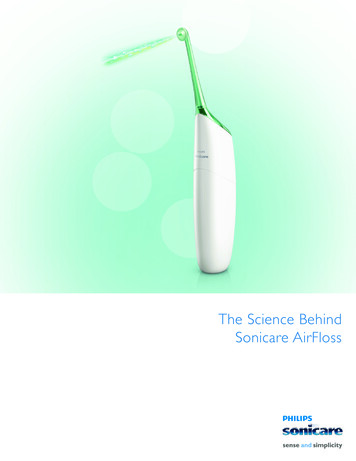
Transcription
The Science BehindSonicare AirFloss
Table of ContentsSafetyPreferencePlaque Biofilm DisruptionGingivitis Reduction and Plaque RemovalCompliance12-456-89
Introduction fromDr. Joerg StrateVice President, Philips Oral Healthcare,Clinical & Scientific AffairsPhilips Sonicare AirFlossThe name of our latest innovation is ambitious: Sonicare AirFloss. For decades, floss wasthe only widely recommended way to manage interdental oral hygiene in addition tothe regular use of a toothbrush. Floss may be considered to be a functional solution,but patients find it difficult to use, resulting in infrequent use or complete omission.Sonicare AirFloss replaces traditional flossing with micro bursts of water and air.Since the technological breakthrough of the first Sonicare power toothbrush, we havelearned a lot about fluid forces and their ability to remove plaque biofilm. SonicareAirFloss is a new technology chapter in the field of oral healthcare. It uses a uniquespray of micro bubbles and a small dose of fluid to generate a gentle and convenient,yet highly effective, interdental cleaning action. Not only does it disrupt plaque biofilmstructures in critical and hard-to-reach areas, it promotes healthy gums with thetargeted release of water/air spray.Sonicare AirFloss continues the Sonicare legacy of technology leadership withinthe oral healthcare segment. And while everything about Sonicare AirFloss seemsquite different from the design and function of Sonicare toothbrushes, there is onearea where AirFloss was submitted to the same rigorous criteria established for allSonicare products: the meticulous clinical validation and verification of performanceand safety requirements. The design and the concept are intriguing in themselves –but our clinical data are extremely convincing. With Sonciare AirFloss, interdentalcleaning has just been reinvented.
Sonicare AirFlossSafetyin vitro studyEvaluation of surface wear by PhilipsSonicare AirFloss and Waterpik WaterFlosser on dental restorative materialsYapp R, Powers JM, Jain V, de Jager M. Data on file, 2010ObjectiveTo investigate potential surface wear caused by Philips Sonicare AirFlossand the Waterpik Water Flosser on a dental restorative material with arelatively low surface hardness.MethodologyTo make this study a worst-case scenario for evaluating erosion of dentalmaterials caused by pressurized water sprays, Durelon polycarboxylatecement (3M ESPE) was chosen because it is a popular luting cement andone of the softest (Vickers hardness of 20).The Durelon specimens were flat discs, 10 mm in diameter and 3 mmthick, lightly polished to create flat surfaces and cleaned in an ultrasonicbath to remove any loose particles. Specimens were capped with softimpression material except in their center, where a round opening 2 mmin diameter allowed exposure to the sprays, such that the unexposedareas would serve as a control.Eight Durelon test specimens were exposed to a total of 2,000 spraypulses with either Sonicare AirFloss or Waterpik Water Flosser (atpressure setting 5). Specimens were positioned at 1 mm distance from thenozzle and perpendicular to the spray, in such a way that water would runoff the specimens to avoid interference with successive sprays.Environmental scanning electron microscope (ESEM) inspection was usedto determine if there was any visual evidence of erosion.1ResultsVisual analysis with ESEM at 8X and 50X magnification did not discloseany difference between the erosion zones and non-erosion zones of anyof the specimens, suggesting that neither the Sonicare AirFloss nor theWaterpik Water Flosser produced any obvious surface damage to theDurelon specimens, through 2,000 spray pulses.ConclusionSonicare AirFloss is safe to use with dental restorative materials.
Sonicare AirFlossPreferenceIn-home use test to evaluate ease ofuse for Philips Sonicare AirFloss versusReach string floss and Waterpik UltraWater FlosserKrell S, Kaler A, Wei J. Data on file, 2010ObjectiveTo assess ease of use of Philips Sonicare AirFloss and two commerciallyavailable interproximal cleaning devices after using each device at homefor one week.MethodologyEligible participants included 59 adult irregular flossers (floss from onetime per month to three times per week). The study utilized a threeperiod, randomized crossover design. The three interproximal cleaningproducts tested were Sonicare AirFloss, Johnson & Johnson Reachunwaxed string floss and Waterpik Ultra Water Flosser (an oral irrigator).The study included four weekly, on-site visits, during which a new devicewas exchanged for the previous device until all of the three interproximalcleaning products were used, per randomized assignment. Participantswere given a survey to report their feedback for the use of each productat the fourth visit. Feedback was recorded through an online questionnaire(Survey Monkey).ResultsAll of the 59 participants completed the study and survey. Overall,participants were highly satisfied with the use of the Sonicare AirFloss.86% and 69% of study participants reported Sonicare AirFloss as easierto use than string floss or an oral irrigator, respectively. 78% reportedSonicare AirFloss as gentler on the teeth and gums than string floss. 81%reported that Sonicare AirFloss provided better access to the back of themouth than string floss.ConclusionAmong a sample of irregular flossers, Sonicare AirFloss was reported byusers to be a preferred alternative for cleaning between teeth, relativeto other commonly used modalities. It elicited significantly higher scoresfor ease of use than floss or an oral irrigator, and Sonicare AirFloss ratedhigher for gentleness on teeth and gums and its ability to provide betteraccess to the back of the mouth compared to string floss.2
Sonicare AirFlossWhich product was easier to use?Sonicare AirFlossReach String Floss86%0%20%40%60%14%80%100%Which product was easier to use?Sonicare AirFlossWaterpik Ultra Water FlosserSame6%69%0%320%40%60%25%80%100%
Sonicare AirFlossWhich product was gentler on your teeth and gums?Sonicare AirFlossReach String FlossSame2%78%0%20%40%60%20%80%100%Which product provided better access to the back of your mouth?Sonicare AirFlossReach String FlossSame4%81%0%20%40%60%80%15%100%4
Sonicare AirFlossPlaque Biofilm Disruptionin vitro studyIn vitro evaluation of interproximal biofilmremoval with Philips Sonicare AirFlossde Jager M, Hix J, Aspiras M, Schmitt P. Data on file, 2010ObjectiveTo evaluate, in vitro, the additional removal of interproximal plaquebiofilm of Philips Sonicare AirFloss when used in combination withPhilips Sonicare FlexCare.MethodologyThis study evaluated interproximal biofilm removal of Sonicare FlexCarewith or without subsequent use of Sonicare AirFloss. An in vitro toothmodel was used to assess the efficacy in removing dental plaque biofilmfrom the interproximal spaces of molar teeth. The dental plaque model wasa multispecies oral biofilm grown on hydroxyapatite discs. In a typodont, thediscs with biofilm were located on interproximal sites of molar teeth at adistance of 2-4 mm from the tip of the bristles or the nozzle. The typodontwas exposed to the dynamic fluid activity generated by the high-frequencybristle movement from the activated Sonicare FlexCare (15 seconds) andby the high-velocity droplet air spray from Sonicare AirFloss (single shot).An inactivated Sonicare FlexCare was used as a control. Plaque removalefficacy was determined by enumeration of the percentage of viable bacteriaremoved from the discs as a result of these exposures.ResultsSonicare AirFloss in conjunction with Sonicare FlexCare removed 66%(p 0.0001) more interproximal biofilm than the active Sonicare FlexCarealone. Sonicare FlexCare active removed significantly more biofilm thanSonicare FlexCare inactive (p 0.0001).ConclusionSonicare AirFloss removed 66% more interproximal plaque biofilm thanSonicare FlexCare alone.Comparison of In Vitro Interproximal Plaque Removal60% of PlaqueBiofilm Removed51.6%4031.0%200Sonicare FlexCare activeplus Sonicare AirFloss5Sonicare FlexCareactive
Sonicare AirFlossGingivitis Reduction andPlaque Removalin vivo studyEffect of Philips Sonicare AirFloss oninterproximal plaque and gingivitisde Jager M, Jain V, Schmitt P, DeLaurenti M, Jenkins W, Milleman J, Milleman K, Putt M.J Dent Res 90 (spec iss A), 2011ObjectivePhilips Sonicare AirFloss is a rechargeable interproximal cleaning devicethat uses a high-velocity burst of air and water droplets to clean betweenteeth. The objective of this study was to evaluate the effect of SonicareAirFloss on interproximal plaque and gingivitis when used in addition tomanual toothbrushing.MethodologyOne hundred forty-eight adults (98 females, 50 males; mean age 39.5years) with moderate gingivitis participated in this single-blind, four-week,parallel, randomized controlled clinical trial. Ethical approval and writteninformed consent were obtained. Subjects were randomized either to amanual toothbrush (two minutes, twice a day) or to a manual toothbrushplus Sonicare AirFloss (once daily, evening). Changes in gingival inflammationwere measured using the Modified Gingival Index (MGI) and GingivalBleeding Index (GBI) at baseline, two weeks and four weeks. The amountof interproximal plaque was evaluated by analyzing the residual proteinconcentration (RPC) of six plaque samples collected from four posteriorsextants (one interproximal site per sextant) and two anterior sextants (threeinterproximal sites per sextant). Baseline plaque samples were collected priorto any intervention. At two weeks, the plaque removal efficacy from a singleuse of Sonicare AirFloss was assessed by collecting interproximal plaquesamples immediately after subjects used their assigned treatment regimen.Safety of the products was assessed through oral examination, prior to allother assessments.ResultsSonicare AirFloss, when used in addition to a manual toothbrush, providedsignificantly greater reductions in gingivitis and bleeding sites (p 0.01) thana manual toothbrush alone. After four weeks, Sonicare AirFloss reducedgingivitis by 33% more, gingival bleeding by 75% more and the number ofbleeding sites by 86% more than a manual toothbrush alone. Interproximalplaque evaluated after a single use showed that Sonicare AirFloss removedsignificantly more plaque than a manual toothbrush alone (p 0.01). Bothproducts were safe to use.6
Sonicare AirFlossConclusionSonicare AirFloss, when used in addition to manual brushing, removedsignificantly more interproximal plaque and resulted in significantlygreater reductions of gingivitis after two weeks and four weeks of use,compared to manual brushing alone.Modified Gingival IndexManual ToothbrushSonicare AirFloss and Manual ToothbrushAdjusted Mean MGI2.01.51.00.50.0BaselineWeek 2Week 4Gingival Bleeding IndexManual ToothbrushSonicare AirFloss and Manual ToothbrushAdjusted Mean GBI0.40.30.20.10.0Baseline7Week 2Week 4
Sonicare AirFlossBleeding SitesManual ToothbrushSonicare AirFloss and Manual ToothbrushNumber of Bleeding Sites3020100BaselineWeek 2Week 4Interproximal Plaque (RPC)Manual ToothbrushSonicare AirFloss and Manual ToothbrushMean Residual ProteinConcentration (µg/ml)403020100Before UseAfter Single Use8
Sonicare AirFlossCompliancein vivo studyIn-home use test to assess complianceof Philips Sonicare AirFlossKrell S, Kaler A, Wei J. Data on file, 20109ObjectiveTo assess compliance of Philips SonicareAirFloss in a sample of irregularflossers after one month of home use.MethodologyEligible participants included 56 adult irregular flossers (floss from onetime per month to three times per week). Participants were given aproduct-usage diary to self report the frequency of usage of theproduct. The study utilized a single-arm design. All participants receivedthe Sonicare AirFloss with a nozzle and travel charger, a daily-usage diaryand product instructions. Per the study instructions, each participant usedthe Sonicare AirFloss at home and recorded his or her usage in the diary.In addition, feedback was recorded using an online questionnaire(Survey Monkey) at the end of one month. Participants were notrestricted from using any other flossing products but were advised touse Sonicare AirFloss in their regular flossing routine.ResultsFifty-one participants completed and returned their daily-usage diaryafter the first month of use. On average, irregular flossers used SonicareAirFloss 1.3 times a day. 96.1% of the participants used Sonicare Airflossfour or more days per week.Conclusion96% of irregular flossers reported use of Sonicare AirFloss fouror more days per week.
Notes10
Notes11
2011 Philips Oral Healthcare, Inc. All rights reserved. PHILIPS and the Philips shield are trademarks of KPENV.Sonicare and the Sonicare logo are trademarks of Philips Oral Healthcare and/or KPENV.www.sonicare.com4235 050 10651
Flosser on dental restorative materials Yapp R, Powers JM, Jain V, de Jager M. Data on file, 2010 Objective To investigate potential surface wear caused by Philips Sonicare AirFloss and the Waterpik Water Flosser on a dental restorative



